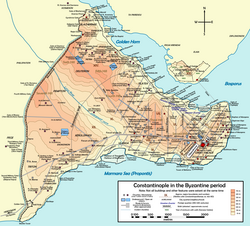Cistern of Aetius
The Cistern of Aetius (Greek: ἡ Κινστέρνη τοῦ Ἀετίου) was an important Byzantine water reservoir in the city of Constantinople.
[4] Although according to a late tradition, the erection of the cistern, which lay in the fourteenth region of Constantinople, dates back to the reign of Emperor Valens (r. 364–78), it is ascertained that it was built in 421 by Aetius, praefectus urbi in Constantinople in 419 and praefectus praetorio Orientis in 425, under Emperor Theodosius II (r.
[3] The giant tank was oriented parallel to one branch of the Mese, the main road of the city which connected the Gate of Charisios with the center of the city passing near the Church of the Holy Apostles,[3] and was supplied by the water main connected to the Valens Aqueduct.
[4] After the Fall of Constantinople in 1453, the 16th-century French traveller Pierre Gilles reported that around 1540 the reservoir was already empty.
[3] Its walls, 5.20 metres (17.1 ft) thick[2] and partially still in place, were built according to the Roman constructive technique named opus listatum by alternating four courses of bricks and ten courses of stone, an elegant pattern similar to that used by the cistern of Aspar.

